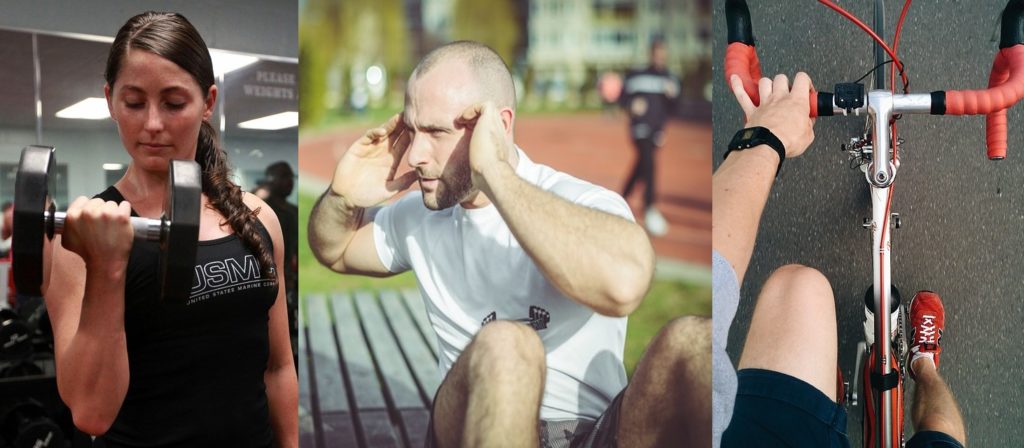
I had a problem.
I had a bunch of injuries, and I’d had them for so long that many of the key muscles in my body were atrophied. I could go to the pool and use a kick-board for 15 minutes, hop out to get a drink from the water fountain, and nearly collapse as my left hip failed. And if I went for a 2-mile walk, my left ankle would be wrecked for the next 48 hours. Lifting weights – even very light ones – left my upper back in spasm for a day or two. I needed to do these exercises to recover from my injuries and rebuild, but it was very easy for me to exercise too much in one day, leaving me too sore to work out the next day.
At the same time, I was dealing with anxiety and depression, and I was newly sober. Because exercise is so good for my brain, I needed it to be a part of my daily routine. The days when I exercised went much better than the days when I didn’t.
Furthermore, even when I wasn’t too sore to exercise, I often found myself unmotivated and struggling to choose which type of workout to do. Legs? Abs? Arms? Cardio? A walk? A bike ride? Swimming? Physical therapy homework? Too many choices sometimes led to a failure to choose at all.
The solution was rotation.
I resolved to establish a rhythm wherein I would exercise exactly one major muscle group each day. The program was simple: arms, abs, legs, repeat. One day would be devoted to arms (and shoulders/upper back): lifting weights, rock climbing, or kayaking. The next day would be ab exercises (and low-back/general core strengthening). The third day would be focused on legs: hiking, biking, skiing, or strength training. By the fourth day, my arms would be ready again, and the pattern would repeat.
Prior to establishing this routine, I would often fail to limit myself when I had an overabundance of willpower, doing too much in one day and winding up too sore to work out tomorrow. The arms-abs-legs rotation allowed me to be consistent in my exercise and consistent in my recovery time. It was a sustainable approach with patience built right into the system. Following the program, I was able to safely exercise some part of my body each day, while still giving the rest of my body adequate time to heal and regrow.
Willpower
These days, my injuries are mostly healed, and my muscles have largely recovered from their state of pitiful atrophy, but I maintain this routine because it has proven to be a great way to strategically reduce my dependence on willpower.
It’s easier to muster the energy to work out if the muscles I plan to use today aren’t sore from recent exertion. Pain, it turns out, is a pretty strong deterrent, and the arms-abs-legs rotation largely prevents me from using muscles that are in pain.
This routine has also reduced the number of decisions I have to make around exercise, which makes it easier for me to get started. There are still choices to be made, but the routine has greatly narrowed those choices. And because my executive function is so poor in the mornings (as I am not a morning person), I decide what specific exercises I’ll be doing the night before. I wake up, put on my workout clothes, and a plan is waiting for me, written on the day’s to-do list.
Finally, as this rhythm turned into a habit, it became easier and easier to get myself to exercise. My rotating daily workout is deeply embedded into my morning routine. I’ve done it for so long, it would be weird not to do it. I still have to use some willpower to work out, but my exercise is mostly set on autopilot.
Exceptions
I’m very consistent about my exercise rotation, but I’m not perfect about it, and there are several reasons for this.
First, not all types of exercise fit neatly into one category. Swimming and yoga, for example, use all three muscle groups. Thus, a serious swim workout or a tough yoga class might be followed by a rest day.
Second, some endeavors, such as climbing a mountain, might leave me sore for several days. Last summer, my cousin and I climbed a minor summit in the Olympics called Valhalla Peak, which wound up being brutally steep: 4500 vertical feet in three miles. My legs were sore for a week, and, during that week, I did very little in the way of leg workouts.
Third, life occasionally throws me opportunities that violate this routine, and I allow myself the flexibility to take advantage. If I’m able to ski two days in a row and the snow is good, I’ll do that, even though it’s two leg days in a row. Or two weeks ago, I had lifted weights on Monday and then got invited to go rock climbing on both Wednesday and Friday, and I went for it. When I began my arms-abs-legs routine (over years ago), three arm workouts in five days would have been way too much for me, but now, because I’ve been so consistent for so long, I have the strength to do it.
Fourth, I sometimes just need a rest day. If two days of recovery isn’t enough, and my body is telling me to take it easy, I listen. I believe it’s important to give myself permission to be human, remembering that, although I often robotically follow this exercise rotation, I’m not actually a robot. And if I fall off the rotation for any reason, I don’t feel guilty or ashamed. I just get back onto it as soon as I can, usually the very next day.
Make your own routine.
My point isn’t that this exercise rotation is the right choice for everyone. My point is that any habitual exercise routine is an effective strategy for making it easier to work out, and if you can design sustainable variety into the program, all the better. Rotating through various muscle groups as I do is just one way you might do that.
The program I’m following surely isn’t perfect, and I’m not following it perfectly, but it has helped me exercise more consistently than any other approach I’ve tried.
So the question I have for you is this: How will you set your exercise on autopilot?
